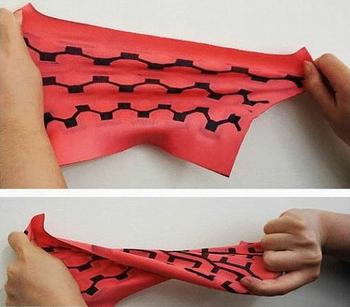
BINGHAMTON, New York, December 7, 2017 (ENS) – In the future, people could wear garments that incorporate power-generating bacteria to support electronic devices. A textile-based, bacteria-powered bio-battery that can be integrated into wearable electronics has been created by a research team at Binghamton University, State University of New York.
Led by Binghamton University Electrical and Computer Science Assistant Professor Seokheun Choi, the team has developed a textile-based bio-battery that exhibits stable electricity-generating capability when tested under repeated stretching and twisting cycles.

Choi said that this stretchable, twistable power device could establish a standardized platform for textile-based bio-batteries and could be integrated into wearable electronics in the future.
“There is a clear and pressing need for flexible and stretchable electronics that can be easily integrated with a wide range of surroundings to collect real-time information,” said Choi.
“Those electronics must perform reliably even while intimately used on substrates with complex and curvilinear shapes, like moving body parts or organs,” he said.
“We considered a flexible, stretchable, miniaturized bio-battery as a truly useful energy technology because of their sustainable, renewable and eco-friendly capabilities,” said Choi.
Sweat generated from the human body can act as a fuel to support bacterial viability, providing the long-term operation of the microbial fuel cells that make up the fabric bio-battery.
“If we consider that humans possess more bacterial cells than human cells in their bodies, the direct use of bacterial cells as a power resource interdependently with the human body is conceivable for wearable electronics,” said Choi.
This work was supported by the National Science Foundation, the Binghamton University Research Foundation and a Binghamton University Analytical and Diagnostics Laboratory Small Grant.
The paper, “Flexible and Stretchable Biobatteries: Monolithic Integration of Membrane-Free Microbial Fuel Cells in a Single Textile Layer,” was published in the journal “Advanced Energy Materials.”
Compared to traditional batteries and other enzymatic fuel cells, microbial fuel cells can be the most suitable power source for wearable electronics because using whole microbial cells as a biocatalyst provides stable enzymatic reactions and a long lifetime, said Choi.
In March, Choi and his team published a paper on their creation of the first micro-scale self-sustaining cell, which generated power for 13 straight days through the symbiotic interactions of two types of bacteria.
“This concept of creating electricity through synergistic cooperation is not new. However, much of this work is still in its nascent stages,” said Choi.
He co-authored the paper, “Self-sustaining, solar-driven bioelectricity generation in micro-sized microbial fuel cell using co-culture of heterotrophic and photosynthetic bacteria,” with PhD candidate Lin Liu.
“The evolution of this technology will require additional exploration, but we, for the first time, realized this conceptual idea in a micro-scale device,” Choi said.
In a cell chamber about one-fifth the size of a teaspoon, researchers placed a mixed culture of phototrophic and heterotrophic bacteria.
Phototrophic bacteria use sunlight, carbon dioxide, and water to make their own energy, while heterotrophic bacteria must feed on provided organic matter or phototrophic bacteria to survive.
While the cell was exposed to sunlight, an initial dose of “food” was added to the chamber to stimulate growth of the heterotrophic bacteria. Through cellular respiration, the heterotrophic bacteria produced carbon dioxide waste, which was used by the phototrophic bacteria to kickstart the symbiotic cycle.
After that cycle was established, researchers stopped adding additional food sources for the heterophic bacteria, and there were enough phototrophic bacteria to sustain the metabolic processes of the heterophic bacteria.
Those metabolic processes generated an electrical current – eight microamps per square centimeter of cell – for 13 straight days. The power was about 70 times greater than current produced by phototrophic bacteria alone.

“Heterotrophic bacteria-based fuel cells generate higher power, while photosynthetic microbial fuel cells provide self-sustainability. This is the best of both worlds, thus far,” said Choi.
These microbial fuel cells could be used to provide power in remote or dangerous locations for low-power items such as health monitors and infrastructure diagnostic sensors.
“There are some challenges of using this technique,” Choi said. “Balancing both microorganisms’ growth to maximize the device performance and the need to make sure that this closed system will permanently generate power without additional maintenance are two we have found. Long-term experiments are needed.”
The current work is the latest in a series of battery-related and microbial-based power studies Choi has worked on. Last spring, researchers connected nine biological-solar (bio-solar) cells into a working bio-solar panel for the first time ever.
The bacteria used in that experiment were phototrophic. That panel generated the most wattage of any existing small-scale bio-solar cells: 5.59 microwatts.
Choi has also developed a microbe-based battery that can use human saliva as a power source, and a battery that can be printed on paper, as well as battery designs inspired by Japanese ninja throwing stars.
The new disposable battery that folds like an origami ninja star could power biosensors and other small devices for use in challenging field conditions.
Copyright Environment News Service (ENS) 2017. All rights reserved.
© 2017, Environment News Service. All rights reserved. Content may be quoted only with proper attribution and a direct link to the original article. Full reproduction is prohibited.
